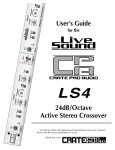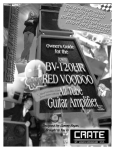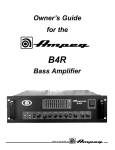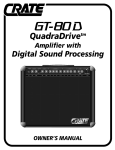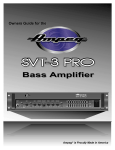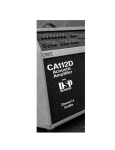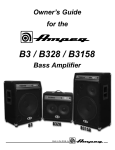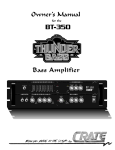Download Crate LS3-231 User`s guide
Transcript
User’s Guide for the LS1-131 LS2-215 LS3-231 Constant Q Graphic Equalizers Crate Pro Audio’s Live Sound Graphic Equalizers feature constant Q circuits which, unlike inferior broad band EQs, let you boost or cut only the frequencies you choose. Combined with a switchable equalization range, these EQs allow greater system control and accuracy whether using them for house coloration, feedback control, or speaker correction. In order to achieve the highest level of performance from your equalizer, please read this owners guide prior to its use. “Thank You” from LS1-131/LS2-215/LS3-231 Constant Q Graphic Equalizers Congratulations on the purchase of your new Crate Pro Audio Live Sound Graphic Equalizer. These outstanding devices have been designed with the audio professional in mind, providing the degree of accuracy and level of quality you demand. Their ease of use and straight-forward design lend them to use by novices as well. This owner’s guide is designed to acquaint you with the workings of these equalizers and how they may be used in your sound system and should be read through before using them. Table of Contents: An Introduction to Equalizers........................................................3 The LS1-131/LS3-231 Front and Rear Panels ................................6 The LS2-215 Front and Rear Panels ..............................................7 Using an Equalizer........................................................................8 Applications: Some Methods of Connection ...........................................9 Room Equalization ..........................................................10 Fletcher-Munson Equal Loudness Contours .....................10 Feedback Control ............................................................11 Creative or Enhancement Equalization ............................11 Technical Specifications .....................................back cover CAUTION ATTENTION VORSICHT RISK OF ELECTRIC SHOCK DO NOT OPEN RISQUE D'ELECTROCUTION NE PAS OUVRIR ELEKTRISCHE SCHLAGGEFAHR NICHT OFFENEN CAUTION: TO REDUCE THE RISK OF ELECTRIC SHOCK, DO NOT REMOVE COVER. NO USER-SERVICEABLE PARTS INSIDE. REFER SERVICING TO QUALIFIED SERVICE PERSONNEL. ATTENTION: POUR REDUIRE D'ELECTROCUTION NE PAS ENLEVER LE COUVERCLE. AUCUNE PIECE INTERNE N'EST REPRABLE PAR L'UTILISATEUR. POUR TOUTE REPARATION, S'ADRESSER A UN TECHNICIEN QUALIFIE. VORSICHT: ZUR MINIMIERUNG ELEKTRISCHER SCHLAGGEFAHR NICHT DEN DECKEL ABENHMEN. INTERNE TEILE KONNEN NICHT VOM BENUTZER GEWARTET WERDEN. DIE WARTUNG IS QUALIFIZIERTEM WARTUNGSPERSONAL ZU UBERLASSEN. THIS EQUIPMENT HAS BEEN DESIGNED AND ENGINEERED TO PROVIDE SAFE AND RELIABLE OPERATION. IN ORDER TO PROLONG THE LIFE OF THE UNIT AND PREVENT ACCIDENTAL DAMAGES OR INJURY, PLEASE FOLLOW THESE PRECAUTIONARY GUIDELINES: CAUTION: TO REDUCE THE RISK OF ELECTRIC SHOCK, DO NOT OPEN CHASSIS; DO NOT DEFEAT OR REMOVE THE GROUND PIN OF THE POWER CORD; CONNECT ONLY TO A PROPERLY GROUNDED AC POWER OUTLET. WARNING: TO REDUCE THE RISK OF FIRE OR ELECTRIC SHOCK, DO NOT EXPOSE THIS EQUIPMENT TO RAIN OR MOISTURE. CAUTION: NO USER-SERVICEABLE PARTS INSIDE. REFER SERVICING TO QUALIFIED SERVICE PERSONNEL. EXPLANATION OF GRAPHICAL SYMBOLS: 2 "DANGEROUS VOLTAGE" = "DANGER HAUTE TENSION" "GEFAHLICHE SPANNUNG" "IT IS NECESSARY FOR THE USER TO REFER TO THE INSTRUCTION MANUAL" = "REFERREZ-VOUS AU MANUAL D'UTILISATION" "UNBEDINGT IN DER BEDIENUNGSANLEITUNG NACHSCHLAGEN" LS1-131/LS2-215/LS3-231 Constant Q Graphic Equalizers An Introduction to Equalizers: The Crate Pro Audio Live Sound Graphic Equalizers are available in two mounting configurations: a 1-3/4” single rack space (LS1-131/LS2-215) and a 3-1/2” double rack space (LS3-231). These equalizers are a perfect addition to any professional sound system, particularly the Crate Pro Audio systems. The Crate Pro Audio LS1-131/LS2-215/LS3-231 equalizers offer precision control of the audio spectrum. Some features of these equalizers include: • Balanced and unbalanced inputs and outputs • Constant “Q” bandpass filter sets for precision control • Two control ranges for greater accuracy • Hardwire switchable bypass from input jacks to output jacks for total elimination of the equalizer from the system • Peak LEDs to obtain optimal signal levels • High signal-to-noise ratio (greater than 94dB) and a wide frequency response (20Hz to 20kHz) • Flat phase response for accurate reproduction and stereo imaging • Very low THD (less than 0.01%) • Maximum input level of +22dBm • Variable low cut and high cut controls (LS1-131/LS3-231 only) • Built in power supply The LS1-131 and LS3-231 provide 31 bands of equalization at standard ISO center frequencies, 1/3 octave apart. They cover the entire audio spectrum from 20Hz to 20kHz. This allows precision control and fine tuning of your audio system. (The LS3-231 offers two channels of 31 band equalizers.) The LS2-215 provides two channels of 15 band equalization at standard ISO center frequencies, 2/3 octave apart from 25Hz to 16kHz. All of the new Crate Pro Audio Live Sound Equalizers incorporate constant “Q” multiple-feedback bandpass filter sets for high resolution with minimal interaction between bands (see Figure 1 below). Figure 1: Constant Q Response: Constant "Q" filters: width of filter does not change with amplitude. 500 1k 2k 5k 0 200 200 Amplitude (dB) Amplitude (dB) 200 Inferior broad band filters: width of filter changes with amplitude. Frequency (Hz) 500 1k 2k ƒ L ƒ C ƒH ƒ = lower frequency ƒ = center frequency L C ƒH = higher frequency 5k 500 1k 2k 1k 2k 5k 0 200 500 Frequency (Hz) ƒ L ƒL ƒH ƒ C 5k ƒH ƒ = lower frequency ƒ = center frequency L C ƒH = higher frequency 3 LS1-131/LS2-215/LS3-231 Constant Q Graphic Equalizers These filters have a relatively low “Q” thus preventing “ringing”. Ringing occurs when a filter instantaneously receives an input signal and hangs on to the signal for a period of time after it has stopped (see Figure 2 below). Figure 2: Q vs. Ringing: 1kHz TONE BURST 1kHz TONE BURST INPUT SIGNAL START INPUT SIGNAL START INPUT SIGNAL STOP INPUT SIGNAL STOP All three equalizers have a flat phase response (see Figure 3 below) for accurate sound reproduction with no coloration to your speaker system. This maintains pure stereo imaging without the “comb filter” effect. As your ear passes across the stereo plane of your system, the comb filter effect sounds like “peaks” and “nulls” in the response which can change the imaging dramatically. Figure 3: Phase Response: 180 150 120 90 PHASE (Degrees) 60 30 Smooth, flat phase response of the Crate Pro Audio equalizers 0 -30 -60 -90 -120 Example of an extremely bad phase response, typical of some "other" equalizers -150 -180 10 4 20 50 100 200 500 1k FREQUENCY (Hz) 2k 5k 10k 20k LS1-131/LS2-215/LS3-231 Constant Q Graphic Equalizers The LS1-131/LS3-231 both feature variable Low Cut and High Cut controls. The low cut control is not only useful for subsonic filtering, but provides a wider range of control for low frequency “ringing” in some sub-woofer systems and controls “wind” noises in microphones. This filter is extremely useful in using amplifier power more efficiently. This is accomplished by eliminating inaudible subsonic frequencies below 30Hz from reaching the system thus conserving power. Most full range P.A. enclosures do not produce frequencies below 30Hz due to speaker limitations. This is typical for all enclosures of this type. Some of these enclosures begin to roll-off at approximately 50Hz with a usable low frequency limit of about 35 to 40Hz (-10dB down). These frequencies may be recovered by using an equalizer to boost the low frequencies to compensate for the speaker’s roll-off. But frequencies below 30Hz may cause displacement-limited distortion, which is distortion due to excessive movement of the speaker cone. Dial the Low Cut control to 30Hz and add a 12dB/octave roll-off at that frequency. This will result in a noticeably cleaner sound. Figure 4a shows the rolloff curves for this control at the frequencies shown on the front panel. Figure 4a: The Low Cut Control: 1dB 0dB -1dB -2dB -3dB 10 15 40 150 250 -4dB -5dB -6dB 10Hz 100Hz 1k The High Cut control can be used to reduce high frequency noise in your source material (instruments, recorded music, etc.) and can help achieve a more natural sound when reproducing some acoustic instruments. Figure 4b shows the rolloff curves for this control at the frequencies shown on the front panel. Figure 4b: The High Cut Control: 1dB 0dB -1dB -2dB -3dB 3k 5k 10k 30k 40k -4dB -5dB -6dB 1kHz 10kHz 50k All units provide a Bypass switch which connects the input jacks directly to the output jacks. This is extremely useful when troubleshooting or comparing your equalizer setting to the original signal. These units also feature a “Range” switch. By pressing this switch, the “boost” and “cut” or control range changes from ±12dB to ±6dB. This allows for greater accuracy. When using these equalizers with a Real Time or Spectrum Analyzer, improved accuracy is important for fine tuning. 5 LS1-131/LS2-215/LS3-231 Constant Q Graphic Equalizers The LS1-131/LS3-231 Front and Rear Panels: NOTE: The LS1-131 is shown; the LS3-231 is identical, except it has two channels, one over the other, in a 2 rack-space enclosure. 1 2 9 10 3 11 4 5 6 7 8 12 13 14 1 - POWER: Use this switch to turn the unit on and off. 2 - EQ SLIDERS: Use these slide controls to make adjustments at the standard ISO 1/3-octave frequencies indicated above each slider. Each slider adjusts the signal ±6dB or ±12dB depending on the setting of the RANGE switch (#3). Moving a slider up boosts the signal; moving it down cuts the signal. The center detent is the “flat” position (no boost or cut). 3 - RANGE: Use this switch to select one of two adjustment ranges for the EQ sliders (#2). With the switch out, the adjustment range is ±12dB. When this switch is depressed, the adjustment range is ±6dB. Care should be taken not to accidentally change the range from 6dB to 12dB during operation if extreme boosts are used, since the boosts will dramatically increase if this occurs. 4 - BYPASS: When depressed, this switch routes the input signal directly from the BALANCED INPUT jacks (#9) to the BALANCED OUTPUT jacks (#10), bypassing the equalizer controls completely. This is useful when comparing the equalized signal to the original. The adjacent LED (linked graphically to the switch with a solid line) glows red when in the bypass mode. 5 - PEAK LED: This indicator glows red when the input or output signal is within 5dB of clipping. Adjust the LEVEL control (#8) so this LED only flashes during strong, peak-level signals. 6 - LOW CUT: Use this control to set the rolloff frequency for the high pass filter. The filter is continuously variable from 10Hz to 250Hz with a rolloff of 12dB/octave. 7 - HIGH CUT: Use this control to set the rolloff frequency for the low pass filter. The filter is continuously variable from 3kHz to 40kHz with a rolloff of 12dB/octave. 8 - LEVEL: Use this control to adjust the input signal level. For the best signal to noise ratio set this control so the PEAK LED (#5) flashes on strong, peak-level signals. The overall output signal level of the equalizer is determined by the setting of this control and the EQ sliders (#2). 9 - BALANCED INPUTS: The mixing board, amplifier or instrument (“source”) may be connected to the equalizer using either of these jacks. However, only one jack may be used at a time. Different methods of connection are described and illustrated on pages 9 and 10. 10 - BALANCED & UNBALANCED OUTPUTS: The equalizer may be connected to the mixing board or amplifier using either of these jacks. The 1/4” phone jack and the XLR jack are balanced. The RCA jacks are unbalanced. Different methods of connection are described and illustrated on pages 9 and 10. 11 - GROUND LIFT: Use this switch to electronically disconnect the signal ground from the mains and chassis earth ground. This may be helpful in eliminating ground loops which cause hum. 12 - VOLTAGE SELECTOR: The equalizer is designed to be used with either 95-130VAC or 190-250VAC power sources. Check the AC line voltage of the outlet and set this switch accordingly before plugging in the unit. 13 - FUSE HOLDER: This contains the fuse for the AC mains. If the fuse blows, replace it with only the same size and type. If the fuse blows repeatedly, check the AC line voltage and the equalizer’s voltage selector switch. If the problem persists contact your Crate Pro Audio dealer. 14 - POWER CORD: Connect the power cord to a suitable source of AC line voltage. Be sure to match the voltage selector switch (#12) to the line voltage before making this connection! In order to reduce the risk of shock, DO NOT defeat the ground pin of the power cord! 6 LS1-131/LS2-215/LS3-231 Constant Q Graphic Equalizers The LS2-215 Front and Rear Panels: 1 2 7 8 3 8 4 5 6 7 2 9 4 4 5 6 10 11 12 1 - POWER: Use this switch to turn the unit on and off. 2 - EQ SLIDERS: Use these slide controls to make adjustments at the standard ISO 2/3-octave frequencies indicated above each slider. Each slider adjusts the signal ±6dB or ±12dB depending on the setting of the RANGE switch (#3). Moving a slider up boosts the signal; moving it down cuts the signal. The center detent is the “flat” position (no boost or cut). 3 - RANGE: Use this switch to select one of two adjustment ranges for the EQ sliders (#2). With the switch out, the adjustment range is ±12dB. When this switch is depressed, the adjustment range is ±6dB. Care should be taken not to accidentally change the range from 6dB to 12dB during operation if extreme boosts are used, since the boosts will dramatically increase if this occurs. 4 - BYPASS: When depressed, this switch routes the input signal directly from the BALANCED INPUT jacks (#7) to the BALANCED OUTPUT jacks (#8), bypassing the equalizer controls completely. This is useful when comparing the equalized signal to the original. The adjacent LED (linked graphically to the switch with a solid line) glows red when in the bypass mode. 5 - PEAK LED: This indicator glows red when the input or output signal is within 5dB of clipping. Adjust the LEVEL control (#6) so this LED only flashes during strong, peak-level signals. 6 - LEVEL: Use this control to adjust the input signal level. For the best signal to noise ratio set this control so the PEAK LED (#5) flashes on strong, peak-level signals. The overall output signal level of the equalizer is determined by the setting of this control and the EQ sliders (#2). 7 - BALANCED INPUTS: The mixing board, amplifier or instrument (“source”) may be connected to the equalizer using either of these jacks. However, only one jack may be used at a time. Different methods of connection are described and illustrated on pages 9 and 10. 8 - BALANCED & UNBALANCED OUTPUTS: The equalizer may be connected to the mixing board or amplifier using either of these jacks. The 1/4” phone jack and the XLR jack are balanced. The RCA jacks are unbalanced. Different methods of connection are described and illustrated on pages 9 and 10. 9 - GROUND LIFT: Use this switch to electronically disconnect the signal ground from the mains and chassis earth ground. This may be helpful in eliminating ground loops which cause hum. 10 - VOLTAGE SELECTOR: The equalizer is designed to be used with either 95-130VAC or 190-250VAC power sources. Check the AC line voltage of the outlet and set this switch accordingly before plugging in the unit. 11 - FUSE HOLDER: This contains the fuse for the AC mains. If the fuse blows, replace it with only the same size and type. If the fuse blows repeatedly, check the AC line voltage and the equalizer’s voltage selector switch. If the problem persists contact your Crate Pro Audio dealer. 12 - POWER CORD: Connect the power cord to a suitable source of AC line voltage. Be sure to match the voltage selector switch (#10) to the line voltage before making this connection! In order to reduce the risk of shock, DO NOT defeat the ground pin of the power cord! IMPORTANT! PLEASE NOTE: The equalizers are equipped with a voltage selector switch (12 on page 6, #10 on page 7). BEFORE PLUGGING THE EQUALIZERS INTO AN AC OUTLET, MAKE SURE THE VOLTAGE SELECTOR SWITCH IS SET TO THE CORRECT RANGE FOR THE AC SOURCE! Improper switch setting may harm the equalizer! 7 LS1-131/LS2-215/LS3-231 Constant Q Graphic Equalizers Using an Equalizer: Mixing and equalizing music requires an experienced ear and knowledge of the different tonal characteristics of each instrument. The voice characteristics of some common instruments are compared to a conventional 88-note piano keyboard in figure 5 below. As indicated on the chart, the piano has the widest frequency range among the instruments shown. This makes the comparison easier to understand. For instructional purposes, we will separate the equalizer bands into six distinct ranges and briefly explain the tonal characteristics of each section. Figure 5: Frequency Range Comparison Chart: PICCOLO FLUTE OBOE CLARINET (Bb) BASSOON TRUMPET FRENCH HORN TROMBONE TUBA TIMPANI CYMBALS VIOLIN VIOLA CELLO BASS VIOLIN SOPRANO ALTO TENOR BASS PIANO 27.50 30.87 32.70 36.71 41.20 43.65 49.00 55.00 61.71 65.41 73.42 82.41 87.31 98.00 110.00 123.47 130.81 146.83 164.81 174.61 196.00 220.00 246.94 261.63 293.66 329.63 349.23 392.00 440.00 493.88 523.25 587.33 659.26 698.46 783.99 880.00 987.77 1046.50 1174.66 1318.51 1396.91 1567.98 1760.00 1975.53 2093.00 2349.32 2637.02 2793.83 3135.96 3520.00 3951.07 4186.01 A B C D E F G A B C D E F G A B C D E F G A B C D E F G A B C D E F G A B C D E F G A B C D E F G A B C Bass Range: (20Hz-125Hz) Unlike the other instruments shown, the piano contains some fundamental frequencies in the 20Hz-40Hz range . The 40Hz-120hz range has a greater audible effect on “low bass”. The electric bass guitar and the acoustic bass both have fundamentals in this region (The “E” string on an electric bass is 41.2Hz). This region provides much of the low end “punch” in bass instruments and drums. Mid-Bass Range: (125Hz-250Hz) The “fullness” of the mix will be determined in this region, either adding a “thicker” or “fatter” characteristic or making it “thin” or “weak”. The guitar and bass both contain fundamentals in this range along with the male or tenor voice. This region also provides the apparent “loudness” of a mix, especially around 160Hz. Low-Mid Range: (125Hz-250Hz) This range tends to add a harsh “muddy” sound when boosted, particularly around 300Hz. This sliders in this region should be adjusted to the detent (flat) position or even reduced slightly to produce a more appealing tonal quality. Mid-Range: (500Hz-4kHz) This is the range at which the human ear is most sensitive. Very small changes in this area can produce a dramatic effect. This region is most commonly reduced in amplitude to produce a rich sound with more emphasis on low bass and upper high end regions. When equalizing individual instruments in a mix, this range becomes very important to bring them to the “front” of the mix, cutting through the rest of the instruments. 8 LS1-131/LS2-215/LS3-231 Constant Q Graphic Equalizers Upper-Mid Range: (4kHz-8kHz) This region is the “presence” range which can determine whether the mix or instrument is “harsh” and “piercing” or “distant” and “muffled”. This range will also help voices and other instruments cut through a mix when boosted. When high frequency “feedback” occurs, this region is one of the most critical in eliminating it. High Range: (8kHz-20kHz) High end, as it is usually perceived, is actually below 12kHz. However, the 10kHz to 16kHz range is used to enhance vocals and wind instruments by bringing out “breath” sounds that give them distinction and clarity. Cymbals on drums can also be made to appear more cutting and clear in this region. The range of 16kHz to 20kHz can be used to compensate for off-axis high frequency deficiencies of horns and tweeters. APPLICATIONS: SOME METHODS OF CONNECTION: There are several different ways to connect an equalizer to a sound system. The equalizer may be connected directly in-line with the signal source (see figure 6 below), to the “insert” jack of a mixer/amplifier’s channel section (figure 7, below), or in-line between a mixer and an amplifier (figure 8, following page). Your dealer can assist you in choosing the connection which is best suited for your particular needs. Figure 6: In-Line with Signal Source: SOURCE MIXER (OR AMPLIFIER) EQUALIZER Source connects to BALANCED INPUT jack of equalizer BALANCED OUTPUT jack of equalizer connects to INPUT jack of mixer or amplifier Figure 7: Connect to an Insert Jack: "Send" side of the signal cable harness connects to the eq's BALANCED INPUT jack IN "Insert" cable harness, connected to the mixer/amplifier's INSERT jack (see detail to the right) EQUALIZER OUT "Return" side of the signal cable harness connects to the eq's BALANCED OUTPUT jack TIP "INSERT" CABLE DETAIL: MIXER (OR AMPLIFIER) TIP TIP TIP RING SLEEVE SLEEVE SLEEVE RING SLEEVE Typical "Insert" cable harness assembly. Stereo end of harness plugs into INSERT jack. "Tip" of stereo end carries signal to one of two mono plugs, "ring" carries signal to other plug. TIP SLEEVE SLEEVE TIP "Send" side of INSERT jack goes to eq's IN jack, "Return" side goes to eq's OUT jack. This may vary from mixer to mixer; some experimentation may be required to achieve the proper results. 9 LS1-131/LS2-215/LS3-231 Constant Q Graphic Equalizers APPLICATIONS: SOME METHODS OF CONNECTION (Continued): Figure 8: In-Line Between a Mixer and Amplifier: MIXER (OR PREAMP) POWER AMPLIFIER EQUALIZER Output signal from mixer/preamp connects to BALANCED INPUT jack of equalizer BALANCED OUTPUT jack of equalizer connects to INPUT jack of power amplifier SPEAKER OUTPUT jack of power amplifier connects to INPUT jack of speaker APPLICATIONS: ROOM EQUALIZATION: Any sound system, whether it is a home stereo, a large sound reinforcement system, or recording studio monitors, will vary in its perceived reproduction depending on its environment; its room. When sound is produced, some frequencies are reflected and some are absorbed. This results in an uneven sound field. If speakers are placed in room corners or against walls, a large increase in the lower frequencies will occur. Some speakers are designed to use this increase to flatten their response. Other speakers, such as near field monitors and P.A. speakers, are designed to be flat in a free air environment (that is, having no external boundaries). These speakers, when placed in the wrong environment, will produce an increased low frequency response. An equalizer may be used to compensate for this condition. By using a spectrum analyzer or Real Time Analyzer (RTA) and any of the Crate Pro Audio Live Sound equalizers, a flat response can be obtained with precision and accuracy. This also may be achieved by ear, though not with the same accuracy, by using a favorite recording with which you are familiar. Another means of achieving a flat response with your system is called “Feedback Tuning” or “Ringing the Room”. This method requires an omni-directional microphone with a very flat response to be placed in the listening area and connected to your system in an unequalized channel of your mixer. With your graphic EQ set flat, slowly turn the gain of your microphone up until a frequency starts to ring (WARNING! Be careful not the let this ring excessively or speaker damage may occur.) Pull down on the EQ slider that makes the ringing stop. Pull only a few dB, not all the way. Increase the system gain again, and another frequency will begin to feed back. Pull down on the corresponding slider again. Repeat this procedure three or four times only. After that, go to the sliders you have not yet moved and bring up their level until that frequency begins to feedback, then pull the slider down until the feedback just stops. Continue this procedure with each slider. This method takes a lot of practice and patience but it will adjust the response of your system to electronically compensate for the room. Additional equalization may be required at this point; the next section will explain. FLETCHER-MUNSON EQUAL LOUDNESS CONTOURS: The human ear does not hear all frequencies equally. For example, the ear is less sensitive to bass notes at lower levels than at higher levels. To compensate for this, additional equalization may be necessary to create a pleasing overall sound, even after a room has been EQ’d. A “preferred curve” is actually a series of boosting and cutting at various frequencies, depending on the overall performance level, so the ear perceives all frequencies at the same level. These curves are known as the Fletcher-Munson Equal Loudness Contours (see figure 9 on the following page). Notice that the amount of boosting changes with overall listening levels, since the ear hears lower frequencies better as the volume level increases. After achieving an electronically flat response from your speakers in the room, use the Fletcher-Munson chart to adjust the contour according to the sound pressure level of the performance. These curves are intended to be used as guidelines only. Experimentation is always necessary to find your own “preferred” sound. 10 LS1-131/LS2-215/LS3-231 Constant Q Graphic Equalizers Figure 9: Fletcher-Munson Equal Loudness Contours: 140 LOUDNESS LEVEL IN PHONS 120 120 200 100 100 20 90 80 80 2.0 70 60 60 0.2 50 40 40 PRESSURE DYNES PER CM2 SOUND PRESSURE LEVEL IN dB 110 0.02 30 20 20 0.002 10 0 0 20 100 1000 FREQUENCY IN Hz 0.000 10,000 FEEDBACK CONTROL: Feedback can be a major problem in live sound reproduction. Feedback occurs when an outgoing signal finds its way back into the system via a microphone or a guitar pickup and gets re-amplified. The outgoing signal is the transmitter and the microphone or pickup is the receiver. The best and most effective way to eliminate feedback is to separate the transmitter from the receiver. If this is not possible, then an equalizer with narrow bandwidth filters, such as the LS1-131 or LS3-231, is an effective alternative. To find the frequency at which the feedback is occurring, simply select the frequency you feel is the problem and move it to maximum “cut”. If the feedback doesn’t stop then return the control back to its original position and adjust another frequency until the feedback stops. Once you have isolated the feedback frequency, then move the control back towards its original position until the feedback occurs again then reduce the level down until it just stops. This process allows you to eliminate feedback problems without sacrificing overall level or frequency response. CREATIVE OR ENHANCEMENT EQUALIZATION: The graphic equalizer can also be a creative tool. The LS1-131, LS2-215 or LS3-231 may be used on individual instruments, vocals, signal processors, and recording equipment to shape or mold them to the exact sound you want. With vocals, the frequencies between 10kHz and 20kHz may be boosted to help separate syllables for greater clarity and distinction. The vocal range is from about 150Hz up to 4kHz. When speech intelligibility is your main concern, this frequency range is critical. Emphasis is typically greater around 4kHz, particularly in a highly reverberant environment. Using your equalizer with a digital reverb gives you the ability to change the characteristics of the “room” or “hall” you’ve selected, offering greater versatility. Your equalizer can also be used to make a “de-esser”. A “de-esser” is what it sounds like, a clever way to control “S’s” in a speech or vocal performance. This will require a compressor with a trigger input. You must first split your vocal source into two output signals. The first vocal signal is simply sent to the input of the compressor. The second vocal signal is sent to the input of your equalizer. The output of the equalizer is sent to the “trigger” input of your compressor. The output of your compressor is sent back to a channel on your mixer. The de-esser is made by boosting the 6.3kHz control to the +12dB position and then adjusting the compressor threshold until the desired effect is reached, that is, when an “S” is pronounced then the signal will be reduced. Some other adjustments can also be made on your compressor with the “attack time”, “decay time” and the “compression ratio” to enhance the effect. 11 LS1-131/LS2-215/LS3-231 Constant Q Graphic Equalizers Technical Specifications Filters LS1-131: 1x31 Constant Q Multiple-feedback 1/3 octave ISO spacing from 20Hz to 20kHz LS2-215: 2x15 Constant Q Multiple-feedback 1/3 octave ISO spacing from 20Hz to 20kHz LS3-231: 2x31 Constant Q Multiple-feedback 1/3 octave ISO spacing from 25Hz to 16kHz Center Frequencies, Hz (±3%) LS1-131/LS2-231: 20, 25, 31.5, 40, 50, 63, 80, 100, 125, 160, 200, 250, 315, 400, 500, 630, 800, 1k, 1.25k, 1.6k, 2k, 2.5k, 3.15k, 4k, 5k, 6.3k, 8k, 10k, 12.5k, 16k, 20k LS2-215: 25, 40, 63, 100, 160, 250, 400, 630, 1k, 1.6k, 2.5k, 4k, 6.3k, 10k, 16k Control Range ±6dB or ±12dB, switchable Frequency Response 20Hz-20kHz ±0.5dB (flat settings) Total Harmonic Distortion Less than 0.01% (20Hz-40kHz +10dBu) Signal to Noise Ratio >94dB (20kHz noise bandwidth) Gain (flat settings) LS1-131/LS2-231: ±12dB Maximum Input Level +22dBm (Level control at center position) LS3-231: -∞ to +12dB Common Mode Rejection Ratio 50:1 Channel Separation 50dB (1kHz) Low Cut Filter 10Hz-25Hz, 12dB/octave High Cut Filter 3kHz-40kHz, 12dB/octave Input Impedance 10k ohms Output Impedance 2.2k ohms Output Impedance 600 ohms Bypass switch “Hardwire” Input to Output Power Requirements 95-130VAC, 50/60Hz 190-250VAC, 50Hz Input AC Power 12W Size (HxWxD) LS1-131/LS2-215: 1.75” (4.5cm) x 19” (48.3cm) x 8.5” (21.6cm) LS3-231: 3.50” (8.9 cm) x 19” (48.3cm) x 8.5” (21.6cm) Weight LS1-131/LS2-215: 4.5 lbs (2.5kg) LS3-231: 9 lbs (4.1kg) Due to ongoing product development and improvement, the specifications contained herein are subject to change without notice. www.crateamps.com ©1999 SLM Electronics, Inc. • A Division of St. Louis Music, Inc. 1400 Ferguson Avenue • St. Louis, MO 63133 47-056-01 • 05/99












